|
|
|
QUELQUES PHOTOS DE VOYAGE 2008
SOME PICS OF THE 2008 JOURNEY
MELAKA ( Malacca )
Malacca
est sans conteste, la ville la plus charmante de la Malaisie.
L’histoire de la ville est des plus romanesque. Anglais,
Hollandais, Portugais, Indiens, Chinois, Aborigènes se sont
battus pour le commerce des épices. A Malacca, les cultures
asiatiques et occidentales se sont rencontrées et
métissées.
De
cette histoire tumultueuse subsistent de nombreux styles architecturaux
et une culture particulière, que l’on retrouve
dans la cuisine (Nyonya). Il faut absolument flâner dans les
ruelles de la vieille ville de Malacca et le quartier de Chinatown pour
constater ce fait.
Pour le shopping, vous y trouverez de nombreuses boutiques
d’antiquaires notamment dans la rue Jalan Hang Jebat. Il
existe encore aujourd’hui à Malacca, un quartier
portugais vers la mer.
Malacca is without unquestionaly, the most charming city
of Malaysia. The history of the city is of the most romantic. English, Dutchman,
Portuguese, Indians, Chinese, Aborigines fought for the trade of the spices. In
Malacca, the Asian and western cultures met and crossed.
From this tumultuous history subsists many architectural
styles and a particular culture, that we recover in the kitchen (Nyonya). It is
necessary to stroll absolutely in the alleys of the old city of Malacca and the
district of Chinatown to note this fact. For shopping, you will find numerous
boutiques of antiquarians notably in the Jalan Hang Jebat street. It exists
again today in Malacca, a Portuguese district toward the sea.
Fondée
en 1396 par " Paraamesware , Malacca était à
l'origine une province du Sumatra; la ville est tombée
successivement aux mains des Portugais en 1511, puis des Hollandais en
1641 et 1813 , puis les Anglais avant de trouver son
indépendance le 20 février 1956. Cette ville
située dans l'État de Malacca, dans le sud de la
péninsule malaise.
Désormais
ville moderne ( on la dit la ville des " musées " et
orientée vers le tourisme, Malacca a malgré tout
su garder une partie de son charme et les alentours de la place rouge (
nom donné en raison des nombreux bâtiments de
cette couleur qui entoure la place ) tout comme le quartier chinois permet encore de se plonger dans un passé prochain
La
vieille ville de Malacca témoigne du mélange
extraordinaire de différents styles architecturaux :
portugais,
hollandais, islamique et chinois.La
ville de Malacca est sans conteste la ville la plus intéressante de
Malaise sur
le plan historique. Le centre ville conserve beaucoup de vestiges de
l'ancienne cité hollandaise, il y a aussi un très
grand
quartier
chinois .Église dans le quartier hollandais; Église St-Paul;
Villa
Sentosa des années 20;
Founded in 1396 by "Paraamesware", Malacca was to the origin a province of
Sumatra; the city fell successively to the hands of the Portuguese in 1511, then
to the hand of Dutchmen in 1641 and 1813, then to the English's hand before
finding it independence on February 20th, 1956. This city is situated in the
state of Malacca, in the south of the Malaysian peninsula.
Henceforth a modern city (people say this is the city of the"
museums" and oriented toward the tourism, Malacca in spite of knowing to keep it
charm and the surroundings of the red place (name given because of the numerous
buildings of this color that surround the place) as the Chinese district permits
to plunge in a next past
The old city of Malacca reveals the extraordinary mixture of
different architectural styles: Portuguese, Dutch, Islamic and Chinese. The city
of Malacca is unquestionably the most interesting city of Malaysia on the
historic plan. The center city keeps a lot of vestiges of the former Dutch city,
there is also a very big Chinese district. Church in the Dutch district; Church
St.-Paul; Sentosa villa of the years of 20;
Depuis
Kuala Lumpur comptez environ 2h de route en bus - 150 km ( nettement
préférable au train peu rapide ) et
coûte 9.40 RM (
$2.70US ) avec la compagnie " Transnational au départ de la
station " Pudda Raya " de KL.
Depuis
la gare des bus de Malacca qui se trouve à
l'extérieur de la ville , il vous faudra prendre soit un
taxi ( tarif de $15 RM - $ 4.29 US officiel mais qui se
négocie ) soit un bus vert ( tourist bus ) pour $1 RM - $
0.29 US qui vous déposera sur la place à
côté de la poste au centre ville
From Kuala Lumpur counts about 2h road by bus - 150 km (distinctly
preferable to train less rapid ) and cost 9.40 RM ($2.70US) with the
Transnational company" to the departure of the station" Pudda Raya" of KL.
From buses station of Malacca outside of the city, you
should take either a taxicab (tariff of $15 RM - $4.29 official but can
negotiate ) either takes a green bus for $1 RM - $0.29 will deposit
you on the place next to the post office to the center city
- Les Églises Saint Paul et Saint François-Xavier : L'église Saint Paul se trouve sur la colline Butik Saint-Paul .Cette église en ruine, toute petite à l'origine est aussi appelé " la dame des collines ", construite en 1521 par les Portugais et où Saint François-Xavier s'est rendu à plusieurs reprises . Depuis 1977 elle est considéé comme patrimoine de la ville et donc protégée. Vous pouvez faire une belle promenade courte et accessible jusqu'au sommet et belle vue sur la ville.
- The Churches Saint Paul and Saint François-Xavier: The church Saint Paul is on the hill Butik Saint-Paul. This church in ruin, small to the origin is also called " The lady of the hills ", constructed in 1521 by the Portuguese and where Saint François-Xavier has harrived many times. Since 1977 it is considered to the heritage of the city and therefore protected.. You can make a short and accessible promenade until the summit and see a beautiful view on the city.

St. Francis Xavier's Church was built in 1849 by a frenchman, Reverend Farve. The Gothic towered church is dedicated to St. Francis Xavier, well-remembered for his missionary work spreading Catholicism to South East Asia in the 16th century...
L'Église de St Francis Xavier a été construite en 1849 par un français, Le Révérend Farve. Le Gothique a dominé l'église est consacrée à St Francis Xavier pour commémorer pour son travail missionnaire Catholicisme qui s'étend au Sud Est de l'Asie au 16e siècle.

Cloché de l' Église St-Paul
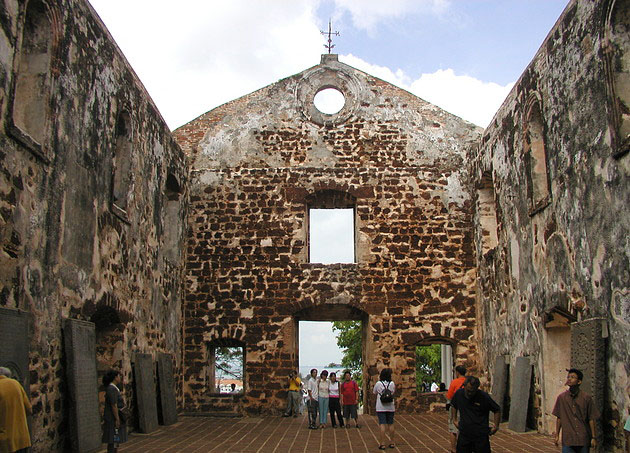
Ruine - Église St-Paul
A low hill on the river's southern bank is occupied by the ruins of the Old Fort, designed by Albuquerque. The Portuguese also built St. Paul's Church (1521), now a ruin, which held the body of St. Francis Xavier until its removal in 1553 to Goa, India.
Une petite colline sur la rive du sud de la rivière est occupée par les ruines du Vieux Fort, conçues par Albuquerque. Les Portugais ont aussi construit l'Église de St Paul (1521), maintenant une ruine qui a tenu le corps de St Francis Xavier jusqu'à son enlèvement en 1553 à Goa en Inde.
- Le Quartier chinois : se trouve de l'autre côté de la rivière dans le old town
China town , Malacca
Malacca, Chinatwon Chinese new year 2008

Architecture de China town Malacca
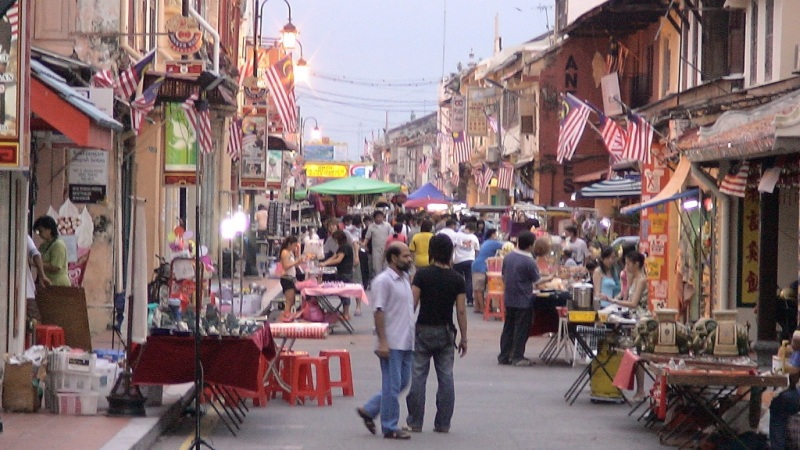
Jonkers walk , this street in Chinatown is closed to car on
Friday and Saturday"
Jonkers walk " cette rue du quartier chinois de Malacca est
fermé au voiture le vendredi et Samedi soir
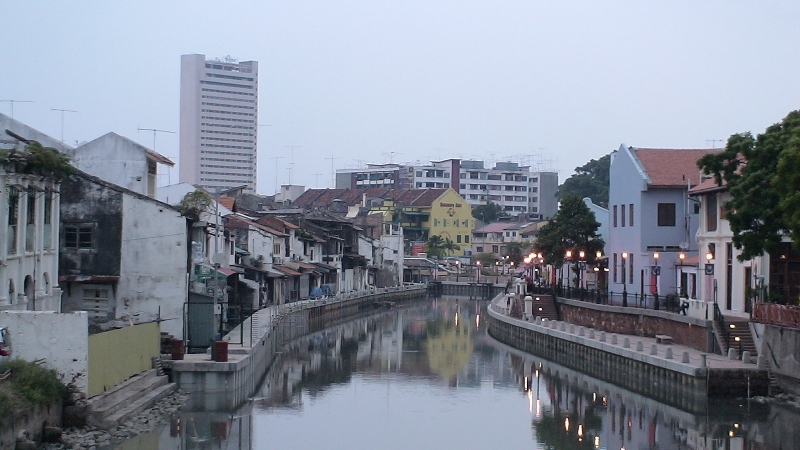
View from the bridge to Chinatown, the river of Malacca
Vue à partir du pont du Quartier Chinois, la rivière de Malacca
- Town Square : Christ church ( datée de 1753 ) et le Stadhuys ( hotel de ville en Hollandais )
Le Stadthuys (1650) était la résidence officielle du Gouverneur hollandais. Maintenant se logent le Musée Historique et le Musée de l'Ethnographie qui ont beaucoup de costumes nuptiaux traditionnels et de vestiges sur l'exposition. Tout près, on trouvera aussi le Christ Church construit en 1753, un autre exemple superbe de l'architecture hollandaise.
The Stadthuys (1650) was the official residence of the Dutch Governor. It now houses the Historic Museum and Ethnography Museum which has many traditional bridal costumes and relics on display. Nearby, one will also find the Christ Church built in 1753, another fine example of the Dutch architecture.
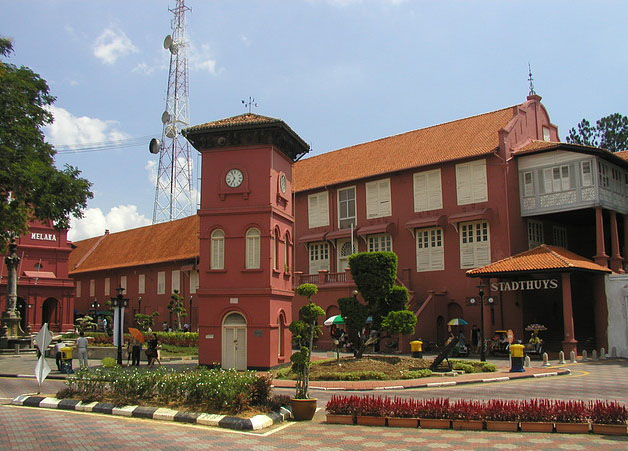
- La Place rouge : quartier hollandais que les Britanniques ont ordonné de peindre en rouge pour signaler tous les bâtiments érigés par leurs prédécesseurs européens.

La place rouge Malacca
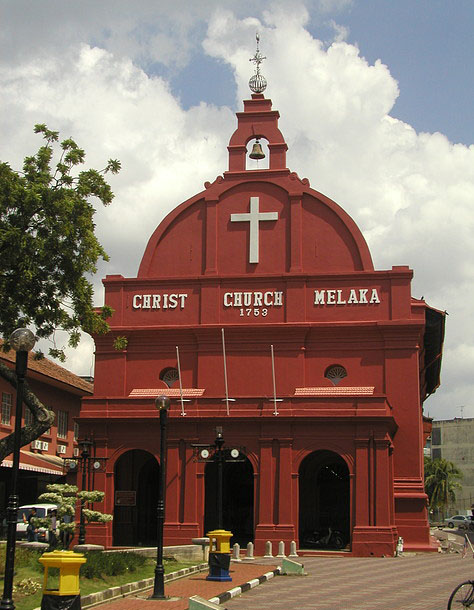
Église hollandaise Christ Church

Malaysian hall of Independence near A famosa fort.
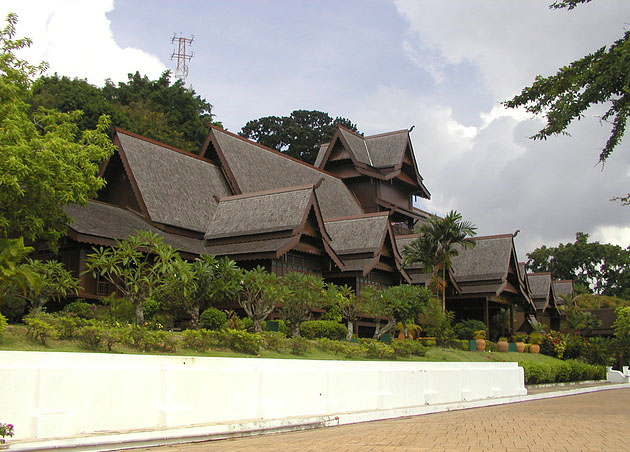
Malacca Sultan palace
--
Introduction Malacca Explorer Malacca